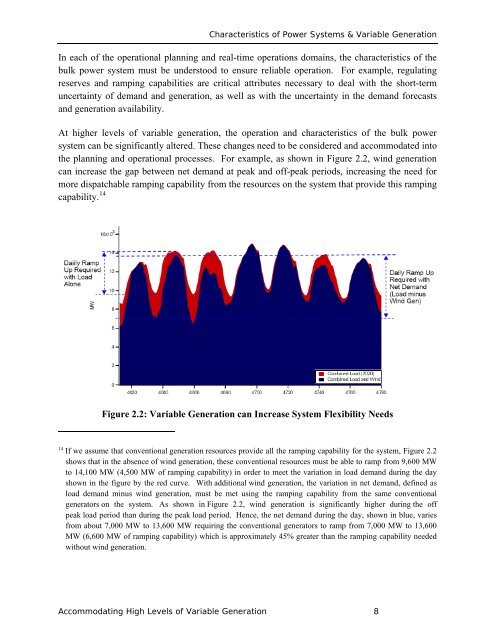Accommodating High Levels of Variable Generation - NERC
Accommodating High Levels of Variable Generation - NERC
Accommodating High Levels of Variable Generation - NERC
Create successful ePaper yourself
Turn your PDF publications into a flip-book with our unique Google optimized e-Paper software.
Characteristics <strong>of</strong> Power Systems & <strong>Variable</strong> <strong>Generation</strong><br />
In each <strong>of</strong> the operational planning and real-time operations domains, the characteristics <strong>of</strong> the<br />
bulk power system must be understood to ensure reliable operation. For example, regulating<br />
reserves and ramping capabilities are critical attributes necessary to deal with the short-term<br />
uncertainty <strong>of</strong> demand and generation, as well as with the uncertainty in the demand forecasts<br />
and generation availability.<br />
At higher levels <strong>of</strong> variable generation, the operation and characteristics <strong>of</strong> the bulk power<br />
system can be significantly altered. These changes need to be considered and accommodated into<br />
the planning and operational processes. For example, as shown in Figure 2.2, wind generation<br />
can increase the gap between net demand at peak and <strong>of</strong>f-peak periods, increasing the need for<br />
more dispatchable ramping capability from the resources on the system that provide this ramping<br />
capability. 14 Figure 2.2: <strong>Variable</strong> <strong>Generation</strong> can Increase System Flexibility Needs<br />
14 If we assume that conventional generation resources provide all the ramping capability for the system, Figure 2.2<br />
shows that in the absence <strong>of</strong> wind generation, these conventional resources must be able to ramp from 9,600 MW<br />
to 14,100 MW (4,500 MW <strong>of</strong> ramping capability) in order to meet the variation in load demand during the day<br />
shown in the figure by the red curve. With additional wind generation, the variation in net demand, defined as<br />
load demand minus wind generation, must be met using the ramping capability from the same conventional<br />
generators on the system. As shown in Figure 2.2, wind generation is significantly higher during the <strong>of</strong>f<br />
peak load period than during the peak load period. Hence, the net demand during the day, shown in blue, varies<br />
from about 7,000 MW to 13,600 MW requiring the conventional generators to ramp from 7,000 MW to 13,600<br />
MW (6,600 MW <strong>of</strong> ramping capability) which is approximately 45% greater than the ramping capability needed<br />
without wind generation.<br />
<strong>Accommodating</strong> <strong>High</strong> <strong>Levels</strong> <strong>of</strong> <strong>Variable</strong> <strong>Generation</strong> 8
















